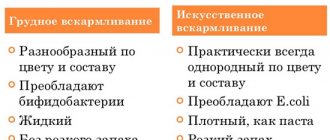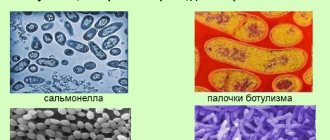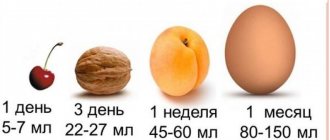Why does a child vomit bile?
Vomiting with bile masses occurs in children with psycho-emotional overload, fatigue, disruption of the vestibular apparatus, and overeating. There are three reasons for vomiting with fever: intestinal infection, poisoning, or an attack of acute pancreatitis.
There are a number of other serious diseases that lead to the problem. This is infectious hepatitis, acute form of cholecystitis, gastritis, duodenitis, as well as the initial stage of meningitis. An additional symptom of meningitis is stiffness of the muscles of the back of the neck and occipital muscles. That is, the child cannot tilt his head forward.
There are also age-related features that result in vomiting of bile.
In infancy
Breasts often burp after feeding. Normally, a white curd mass is regurgitated. If this mass is colored greenish or yellow, then there is reason to be wary and immediately contact your local pediatrician.
Contact a doctor immediately if the baby’s stomach is hard, there is blood discharge, vomiting is “fountaining,” the temperature has risen, and there is no bowel movement.
It could be:
- Congenital pathology of the gastrointestinal tract. This includes intestinal obstruction, narrowing of the pyloric section of the child’s stomach, and pathology of the biliary tract.
- Difficult or premature birth, when the baby may have swallowed amniotic fluid, can cause regurgitation of yellow masses. This syndrome is observed especially in premature infants, whose gastrointestinal tract is imperfect due to premature birth.
- Unsuccessful childbirth, when the child has experienced hypoxia, can cause neurological disorders. This also affects the feeding process; nervous spasm leads to the reverse flow of food mixed with bile.
Regurgitation of food and vomiting in a baby are not the same thing. The latter is always a pathology. You should immediately consult a doctor, especially if the vomit is mixed with bile.
In relation to children in the first months of life, no initiative should be taken, especially when such terrible symptoms as vomiting with bile are observed.
In children from one year old and teenagers
At the age of one year and older, vomiting bile is not that uncommon. It can be caused by fatty foods, headaches, nervous tension, and unusual foods. As a rule, vomiting occurs once. The child comes to his senses very quickly after it and feels normal. But this doesn't always happen. Parents should know what can cause:
- If your baby vomits bile in the morning, it may mean he was fed a fatty, heavy meal the night before. If this is not followed by any other signs, this is a clue that it is not advisable to feed children at night. Any malnutrition can cause vomiting, sometimes with bile.
- A teenager may vomit bile after alcohol poisoning or after smoking his first cigarettes in his life. These are signals for parents that are more of a pedagogical nature than a reason to see a doctor.
- If vomiting of bile is preceded by nausea, pain in the right hypochondrium, then most likely the provocateur is gallbladder disease - cholecystitis or bile duct dyskinesia. You should consult a doctor immediately.
- Vomiting of bile without fever or diarrhea can be caused by intestinal obstruction caused by adhesions, volvulus, or diverticulosis of the colon. Such dysfunctions are accompanied by severe pain and bloating. The situation is extremely serious and requires hospitalization and surgical intervention. Vomit has a characteristic odor similar to feces.
- An acute attack of pancreatitis also causes similar symptoms. The presence of bile in the vomit is explained by the fact that it is inflammation of the biliary tract that provokes acute pancreatitis. All this is accompanied by acute girdling pain and fever.
Signs that indicate bile in the stomach
Vomiting is always preceded by nausea . Small reflux of bile is accompanied by systematic belching. In infants, this condition affects overall physical development - stunted growth, poor weight gain, restless sleep.
Gagging is caused by sharp contractions of the diaphragm, and for children this is a painful process. The discomfort is intensified by a feeling of bitterness in the mouth, heartburn, and heaviness in the iliac region. Children constantly experience a feeling of thirst, general weakness and loss of strength. Physical activity decreases sharply. Periodically, the child vomits bile.
Characteristics and coloring of vomit:
- green vomit – contains a large amount of bile, occurs during or after eating;
- if a child vomits yellow liquid - this is a mixture of bile and gastric juice, it happens on an empty stomach;
- vomit of a dark green hue with brown streaks - the presence of bile against the background of gastric bleeding of low intensity.
The condition may worsen - vomiting with fever, chills appear, the skin turns pale, becomes cold and sticky, and diarrhea occurs . This indicates an infectious or acute inflammatory process in the child’s body. If there is no rise in temperature, functional disorders of the digestive system occur in the body.
Fever, diarrhea and other associated symptoms
With a combination of fever, vomiting and diarrhea, the following can be assumed:
- The child was poisoned by stale food. Although the point here is not poisoning, but the fact that a whole colony of pathogenic bacteria has appeared in stale products. Once in the baby’s gastrointestinal tract, they suppressed the beneficial intestinal microflora and began to multiply rapidly. Hence the fever, nausea, vomiting and diarrhea. All this is accompanied by a headache. Here you cannot do without special antibiotics for the gastrointestinal tract.
- Pancreatitis will paint the same picture. But in addition there is severe pain of a girdle nature.
- An attack of cholecystitis can cause an increase in temperature to 40°C and severe pain in the right hypochondrium. Vomiting with bile in cholecystitis is an obligatory component. Diarrhea may or may not happen.
- The same picture is given by parenteral or enteral hepatitis. The first type is given to the child through a blood transfusion or injection. These are hepatitis B, C, D and G. The second type of hepatitis appears as a result of infection with viruses of groups A and E from infected water or dirty hands.
When vomiting is accompanied by diarrhea and fever, signs of dehydration may appear.
If a child vomits in the morning, this indicates overeating of fatty, spicy or fried foods consumed during dinner.
It is necessary to give the child plenty of fluids with rehydrants (for example, Regidron), which should be in every home medicine cabinet. Without them, the baby's condition will worsen every minute.
First aid
- First of all, parents should calm themselves and their child, as episodes of vomiting are always alarming. You need to call a doctor and wait for him, without leaving your baby for a minute.
- To prevent the contents of the digestive tract from entering the baby's respiratory system, make sure that the baby is not lying on his back. The optimal position after vomiting is vertical. If the child is lying down, turn his head to the side.
- It is important to start giving your child fluids right away to prevent dehydration from developing. The best drinking option is considered to be solutions of glucose and salts, which are made from pharmaceutical powder preparations. You can also prepare similar solutions at home using sugar, soda and salt. Such solutions are given in small portions (a teaspoon) every five to ten minutes.
- No medications, especially antibiotics and antiemetics, should be given until the baby is examined by a doctor.
What should parents do?
If a child begins to have attacks of vomiting mixed with bile, while the body temperature rises, there is bloating and pain, it is necessary to urgently call a doctor or an ambulance. Any of your actions can aggravate the already difficult situation of the child.
First aid
Before the ambulance arrives, try to position the child so that he cannot choke on vomit. Place pillows under his back so that his head is much higher than his body. Give him something to drink: even if it makes him vomit after a while, it will flush his stomach. This is important if a child is poisoned by poor-quality food. It is advisable to give the child enterosorbents that will absorb bitterness, bile and toxins that poison the gastrointestinal tract.
The first thing parents should do is calm the baby. To do this, they themselves need to pull themselves together and not show fear or panic. After clearing the baby of vomit, try to soberly assess the situation:
- Examine the baby's tummy: is there any bloating?
- Ask your child, if he can speak, whether his stomach hurts, whether he feels sick or not.
- If there is no swelling and the temperature does not rise, then poisoning may be occurring. First aid for poisoning is to give the baby a 1% saline solution, which will induce vomiting. Then give an enterosorbent, which will help the digestive tract cleanse itself of pathogenic microflora and toxins, cover the intestines with a protective film, and absorb gases, preventing bloating and flatulence.
- You can very carefully palpate the baby's tummy, observing his reaction. Based on where the grimace of pain appears, you can judge what caused the problem. The right hypochondrium is the gallbladder or liver, the iliac region is the stomach or pancreas. The left or right side is slightly lower - colon diverticulosis is possible. Then you need to urgently call an ambulance.
Should I call a doctor?
If the vomiting was one-time, and gastric lavage and taking enterosorbent had their effect, then there is no need to call a doctor. The condition of the child will show you this. But there are cases, which have already been mentioned above, when calling a doctor, and sometimes an ambulance, is necessary:
- Vomiting of bile in a child with fever does not stop; each intake of liquid causes a new attack.
- A high temperature has risen (above 38.5°C) and does not fall.
- The baby's belly is swollen and painful, causing crying.
- Vomiting bile is accompanied by diarrhea and high fever. There is nothing to think about; you need to urgently call a doctor or an ambulance.
In these cases, you should immediately consult a doctor.
Drug therapy
If a child is vomiting bile, then without diagnosis it is better to refrain from unauthorized “prescribing” of medications.
The most common cause of gallbladder disease is the early transfer of a child to a common family table. The enzyme system in children under 7 years of age is still poorly developed, so an adult diet is not suitable for them. Also, vomiting with bile can be a harbinger of appendicitis.
But there are universal drugs:
- Rehydrants – Rehydron or Trihydrosol, which you should always have in your first aid kit. These solutions will help prevent dehydration in children and adults.
- Enterosorbents. There are several types of enterosorbents, each of which performs certain protective functions for gastrointestinal disorders. Carbon enterosorbents are the most common of them (Activated carbon, Sorbex, White carbon, etc.).
- Silicon-containing sorbents in the form of powder or paste, for example, Enterosgel, can even be given to infants by stirring them in milk. This sorbent removes endogenous and exogenous toxins from the gastrointestinal tract, formed during the life of pathogenic microflora, without affecting the beneficial intestinal microflora.
Hospital procedures
When a child vomits bile, the situation is force majeure; here you can only provide all possible first aid and wait for the local doctor or ambulance. The necessary procedures can only be performed in a hospital setting:
- Gastric lavage using a tube in case of severe poisoning.
- An enema or Esmarch mug is given to a child to cleanse the intestines in order to conduct further studies of the gastrointestinal tract.
This is where all procedures end until the reasons are clarified.
Diet recommendations
When the child’s vomiting stops, he should be fed only on demand, in small portions, avoiding the following foods:
- drinks containing caffeine;
- sparkling water and sweets;
- fatty, heavy foods.
You need to prepare light vegetarian puree soups, liquid porridges with water, rosehip decoctions as tea (can be sweetened with honey.) Then you can add fermented milk products - natural yoghurts without sweeteners with biscuits. This is how you should feed your child, gradually transferring him to his usual diet.
Surgery
If a child has adhesions, intestinal volvulus, and as a result, intestinal obstruction, then surgical treatment is indicated for him. Such treatment is carried out only if conservative methods fail. The operation is performed using two methods:
- Abdominal surgery. The abdominal cavity is opened and the twisted intestine is untwisted or part of the intestine affected by necrosis is removed.
- Laparoscopy method. A puncture is made in the peritoneum and a laparoscope is inserted - a device equipped with a television camera, a light source and surgical manipulative instruments. This is a gentle surgical method. Thanks to this method, bloodless operations are performed to remove the appendix, gall bladder, etc.
Folk remedies
If a child has had a one-time vomiting of bile, folk remedies can be given to soothe irritated mucous membranes of the digestive organs.
Recipes for infusions and decoctions of medicinal herbs:
- Infusion of chamomile and angelica. 1 tsp. Infuse herbs in a glass of boiling water for 1.5-2 hours, take 10-15 ml three times a day 30 minutes before meals.
- Brew dill seeds (1 tsp) in 200 ml of boiling water. Drink 1 tbsp. l. before eating.
- Brew rose hips in a thermos overnight. 1 tbsp per 0.5 liter of water. Give your child water between meals.
Causes of vomiting mixed with bile in children over one year old and adolescents
The enzyme system in children continues to develop until the age of 7, so it is recommended that they gradually introduce food from the common family table into their diet so as not to provoke disruption of the gastrointestinal tract. The main factors that provoke vomiting in young children: fatty foods, poisoning or acquired pathologies.
The reason for the release of bile in vomit in adolescents:
- side effects of drugs (tetracycline antibiotics);
- diseases;
- excessive consumption of fast food;
- food, drug, alcohol poisoning;
- intoxication with chemicals.
The parent must monitor the child’s condition and carry out the necessary therapeutic measures. If there is no tendency to feel better within 6–12 hours, call an ambulance and undergo treatment in a hospital.











